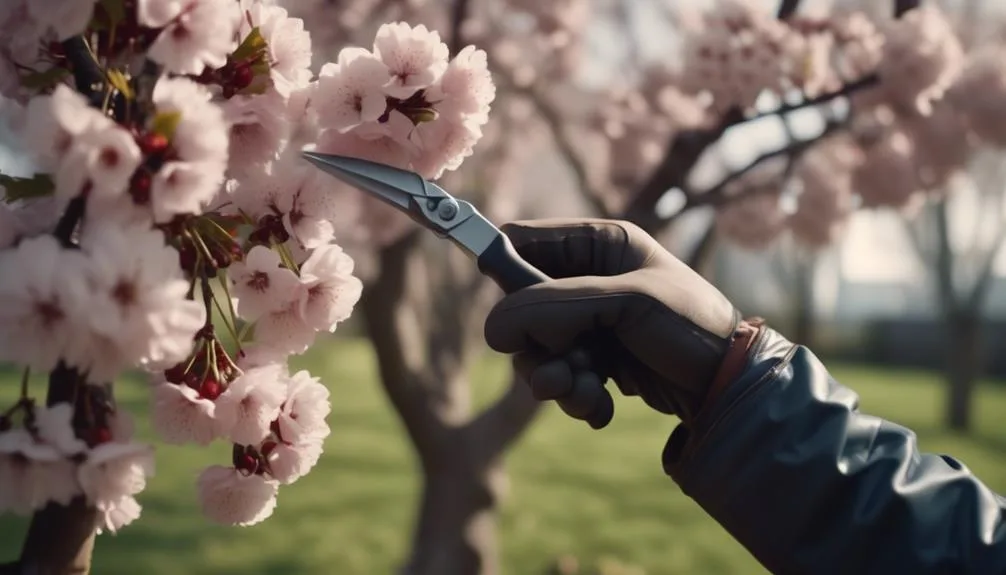Are you ready to grow your own cherry tree?
Before you start dreaming of juicy cherries, there are important steps to learn.
From finding the right spot to enjoying your first harvest, this guide will help your cherry tree thrive.
Whether you're a seasoned gardener or a beginner, you'll learn how to care for your tree from a small plant to a fruitful garden centerpiece.
Planting Cherry Trees
When planting cherry trees, ensure that the chosen location receives full sunlight for optimal growth and fruit production. Before planting, prepare the soil by ensuring it's well-drained and rich in organic matter. Cherry trees prefer slightly acidic soil with a pH of 6.0 to 6.5.
Dig a hole twice as wide as the root ball and mix in compost or peat moss to improve soil quality. After planting, apply a layer of mulch around the base of the tree to retain moisture, regulate soil temperature, and suppress weed growth.
Properly spacing the trees is crucial for their healthy development. Sweet cherry trees should be spaced 20 to 25 feet apart, while sour cherry trees can be spaced closer, around 15 to 18 feet apart.
Watering and Fertilizing
After planting your cherry trees and ensuring they've a good start in the well-drained, compost-enriched soil, the next crucial step is to understand the proper watering and fertilizing techniques.
Proper watering and fertilizing are essential for the healthy growth and fruit production of your cherry trees. Here are some key points to keep in mind:
- Soil Testing
- Conduct regular soil tests to ensure the pH levels and nutrient content are optimal for cherry tree growth.
- Adjust the soil pH and nutrient levels based on the results of the soil tests.
- Mulching Techniques
- Apply a layer of organic mulch around the base of the cherry trees to help retain moisture, regulate soil temperature, and suppress weed growth.
- Use mulch materials such as wood chips, straw, or compost to maintain a healthy growing environment for your cherry trees.
Pruning and Trimming
To maintain the health and productivity of your cherry trees, regular pruning and trimming are essential tasks that should be performed throughout the year.
Seasonal timing is crucial for the overall success of your cherry tree care. In the winter, focus on removing dead or diseased wood to promote new growth.
Spring is an ideal time for shaping and thinning to improve air circulation and sunlight penetration.
In the summer, prune minimally to avoid stressing the tree. Techniques such as thinning cuts, heading cuts, and reduction cuts help maintain branch structure and aesthetics.
When pruning, always use sharp, clean tools to make precise cuts. Additionally, consider the tree's natural form and growth patterns to enhance its overall appearance.
Proper pruning and trimming not only improve the tree's structure but also encourage fruit production.
Pest and Disease Management
Effective pest and disease management is crucial for preserving the health and vitality of your cherry trees. To keep your trees in top condition, consider the following:
- Integrated Pest Management (IPM)
- Use natural predators, like ladybugs and lacewings, to control common pests such as aphids and mites.
- Employ pheromone traps and sticky barriers to monitor and control insect populations without resorting to chemical pesticides.
Harvesting and Maintenance
For optimal cherry tree health and fruit production, regular maintenance and proper harvesting techniques are essential. It's important to pick cherries at the right time to ensure they're sweet and ripe. Here are some tips for cherry picking and tree maintenance:
| Cherry Picking Tips | Tree Maintenance |
|---|---|
| Wait until cherries are fully colored and firm before picking. | Prune your cherry tree annually to remove dead or diseased branches. |
| Gently twist the cherries to harvest, leaving the stems intact. | Fertilize the tree in early spring and mulch around the base to retain moisture. |
| Harvest cherries in the morning when they are cool and firm. | Monitor for pests and diseases, and take appropriate action if necessary. |
| Avoid picking wet cherries to prevent spoilage. | Water the tree deeply during dry periods, especially during fruit development. |
| Store cherries in a cool place and consume or preserve them promptly. | Check for signs of stress such as wilting or yellowing leaves, and address any issues promptly. |
Following these tips will help maintain the health of your cherry tree and ensure a bountiful harvest for years to come.
Conclusion
Now equipped with the essential tools and knowledge for cherry tree care, you can nurture your trees with confidence. This involves ensuring proper planting, watering, pruning, and pest management.
By providing attentive care, your cherry trees will flourish. They will yield a bountiful harvest of delicious fruit for years to come.
Happy gardening, and may your fruitful endeavors bring joy and satisfaction to your garden.

My interest in trees started when I first saw the giant sequoias in Yosemite.
I was a teenager then, and I remember thinking, “I need to learn more about this.”
That moment stuck with me.
A few years later, I went on to study forestry at Michigan Tech.
Since graduating, I’ve worked in a mix of hands-on tree care and community education.
I’ve spent over ten years helping people understand how to plant, maintain, and protect the trees in their neighborhoods.
I don’t see trees as just part of the landscape.
They are living things that make a real difference in our daily lives.
